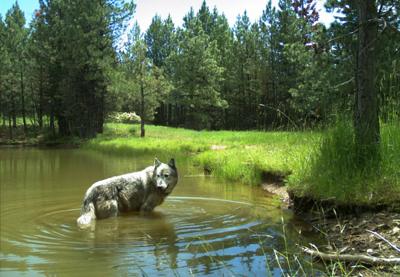WASCO CO. — Is this bad news or good news? Depends who you ask.
“It’s a relief,” said Amaroq Weiss, senior wolf advocate at Portland’s Center for Biological Diversity.
While Oregon saw the first noteworthy increase in its wolf population since 2019 last year, breeding pack members are dying and fewer pups being raised in eastern Oregon.
The state’s wolf population grew 15% in 2024, according to the 2024 annual Oregon Wolf Conservation and Management report.
The number of successful breeding pairs continues to fall in the eastern state, however, reaching its lowest level since 2017, noted Weiss. There, 10 wolf packs successfully raised just two known pups.
Western Oregon saw an increase in successful breeding pairs, with seven.
“One reason we’re seeing a decrease in breeding pairs is not just that their pups didn’t survive, but that the breeders themselves are getting illegally killed,” Weiss said. “Animals are also being legally killed [by ODFW].”
Population growth has fallen since 2019; in 2023, no new wolves appeared.
“Those of us in the conservation community have been pretty concerned during all of those years, because the other thing we were seeing at the same time was a big uptick in illegal killing, otherwise known as poaching, and also a big uptick in agency killing in response to livestock conflicts,” Weiss said.
Last year, 26 new wolves appeared, bringing Oregon’s total to 204. But poaching remains high, and may be even higher than the data shows. That reduces livestock producers’ options for lethal control as well, since the small western population remains protected.
However, science shows lethal control doesn’t work well anyway, Weiss said.
Right now, lethal control is allowed if a particular wolf kills multiple livestock animals within a few months.
Sometimes, wolves stop going after livestock after one is killed. Other times, the lethal removal by ODFW of adults sends young wolves with undeveloped hunting skills in search of the easiest prey — more livestock.
In one case, ODFW ended up killing an entire pack — right down to the 4-month-old pups. In the last two years, lethal removals doubled — 16 wolves from 10 packs in 2023.
Studies in both North America and Europe found that when more legal killing is allowed, poaching rises, too.
Illegal killing
Intense poaching over the last two years is delaying the recovery of wolf populations — thus reducing farmers’ options for dealing with livestock predation, since wolves remain protected.
In Oregon, wolves account for just 0.002% of annual livestock losses, according to U.S. Department of Agriculture reports. This is typical in the West, where Montana’s thousand or so wolves are responsible for about 0.03% of deaths.
West of Highway 97, wolves are federally listed under the Endangered Species Act (ESA). As their population grew, they would’ve entered a later, more flexible phase in state wolf management plan — b poaching in 2023 cut their numbers.
The deaths of seven wolves are under investigation in Oregon. Two where shot; four others were poisoned. The seventh wolf came from the federally protected west zone.
In 2025, at least two wolves have been poached so far, Weiss said.
Rewards offered for information on the killings have reached almost $200,000, according to reporting from Oregon Public Broadcasting. But unlike other animals, wolves somehow inspire people to keep silent about poachers’ work.
Weiss and colleagues, going back roughly 30 years, could only remember at most three cases where people came forward to report the poaching of wolves.
“The illegal killing of wolves remains a significant and ongoing concern in Oregon, including in areas like Wasco County. Wolves in this region are protected under the federal Endangered Species Act, and unlawful harm or killing is a violation of federal law,” wrote Aaron Bott, Regional Wolf Biologist for the Oregon Department of Fish and Wildlife (ODFW).
Poaching has stayed high for years now. Some 51 wolves have died since 2012, according to the Center for Biological Diversity — more than half of those within the last four years.
“Scientific research has shown that for every illegally slain wolf that’s found, another one to two wolves have been killed and remain undiscovered,” read their press release.
So what’s the alternative? Weiss has a story: “In Montana, there’s a ranching family. The woman’s name is Hillary Zaranek-Anderson. She used to be a wolf biologist in Yellowstone, and she married a rancher, and so she quit her biology work and started doing ranching. They ranch in the Centennial Valley, which has the highest number of wolves and grizzly bears anywhere in the Lower 48 — and they do not have wolf predations or grizzly predations, because they monitor their livestock. They’re out there watching over them. They’ve taught them to stay bunched up in herds.
“It’s like a whole different methodology than what people have been doing for ranching over the last 100 years, since wolves have been gone. So it’s quite possible...”
Columbia Gorge News will keep covering the controversial return of wolves to our region and would like to hear from readers. If you have a local story about wolves, or know someone who does, email florag@gorgenews.com.
























Commented
Sorry, there are no recent results for popular commented articles.